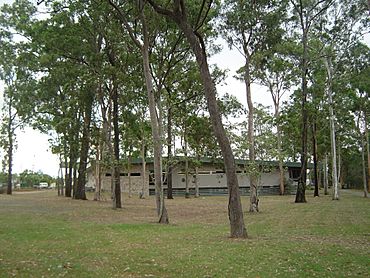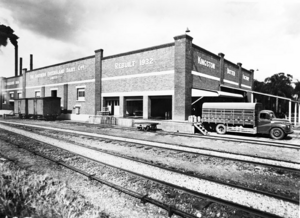Kingston, Queensland facts for kids
Quick facts for kids KingstonLogan City, Queensland |
|||||||||||||||
|---|---|---|---|---|---|---|---|---|---|---|---|---|---|---|---|

Marsden library is located in the far south of the suburb
|
|||||||||||||||
| Population | 10,506 (2021 census) | ||||||||||||||
| • Density | 1,568/km2 (4,060/sq mi) | ||||||||||||||
| Postcode(s) | 4114 | ||||||||||||||
| Area | 6.7 km2 (2.6 sq mi) | ||||||||||||||
| Time zone | AEST (UTC+10:00) | ||||||||||||||
| Location |
|
||||||||||||||
| LGA(s) | Logan City | ||||||||||||||
| State electorate(s) |
|
||||||||||||||
| Federal Division(s) | Rankin | ||||||||||||||
|
|||||||||||||||
Kingston is a town and suburb located in the City of Logan, Queensland, Australia. It's a place where many people live. In 2021, about 10,506 people called Kingston home.
Contents
Discover Kingston's Location
Kingston is mostly a place where houses are built. You'll also find some areas for factories, shops, and businesses. A creek called Scrubby Creek forms the southern border of the suburb. This creek flows into the Logan River. Kingston is also home to the famous Kingston Butter Factory.
Kingston's Past: A Journey Through Time
Kingston got its name in 1890 from Charles and Harriet Kingston. They lived in the area during the late 1800s.
Early Days and the Butter Factory
Like other parts of Logan City, Kingston was once part of the Shire of Tingalpa. Farming, especially dairy farming, became very important here from the 1890s. In 1906, people decided to start a co-operative butter factory. The Southern Queensland Co-operative Dairy Company opened its factory in Kingston in June 1907.
A pig farm was set up nearby in 1926. The pigs were fed with buttermilk from the factory. The Kingston Butter Factory grew bigger in 1932 and worked well for many years. However, after World War II, the dairy industry changed, and the factory eventually stopped making butter in 1983.
Today, the Kingston Butter Factory is a community arts centre. It has a theatre, places to buy arts and crafts, and a museum. It's listed on the Logan City Council Local Heritage Register because of its important history and what it meant to the community.
Land Sales and Early Schools
In October 1885, land blocks called "Kingston Railway Station Estate" were sold. These blocks were advertised as having great views and being close to the Kingston Railway Station.
Kingston State School opened its doors on 8 July 1912, teaching primary school students. Later, Kingston State Infants School opened on 27 January 1976, but it closed in 1993.
Gold Mining in Kingston
Another important activity in Kingston was gold mining at Mount Taylor. Gold was first found there in 1885. Mining began underground in 1913. In 1932, the Kingston Gold Mining Company started digging for gold from the surface in an open cut mine. Mining continued until 1954. After the mine closed, the area was used as a waste dump. It was later filled in and turned into a housing area in the late 1960s.
High School and Other Changes
Kingston State High School was built in Bega Road and opened on 24 January 1977. It was officially opened by the Minister for Education, Val Bird. Students from Kingston and nearby suburbs like Marsden and Woodridge attend this school. On 1 November 1999, it was renamed Kingston College.
In 1985, the suburb of Logan Central was created. It took some land from Kingston and Woodridge. Kingston Centre for Continuing Secondary Education opened on 4 February 1991. Groves Christian College, a private school, opened in 1999.
Who Lives in Kingston?
In 2016, Kingston had a population of 10,539 people. About 5.9% of the people were Aboriginal and Torres Strait Islander. Most people (55.4%) were born in Australia, but many also came from New Zealand (9.2%), Samoa (2.1%), and England (2.1%).
Most people (64.0%) spoke only English at home. Other languages spoken included Samoan, Karen, and Hindi. The most common religions were "No Religion" (25.4%) and Catholic (14.3%). The average age of people in Kingston was 31 years old.
By 2021, the population of Kingston was 10,506 people.
Kingston's Environmental Story
The Mount Taylor Gold mine, located near Queens Road and Kingston Road, operated from 1898 to 1955.
The Start of the Issue
In 1931, chemicals like cyanide and acid waste from the gold refining process were put around the mine site. After the mine closed in 1955, the local council allowed waste from recycled oil processing to be dumped into a pit there. This continued until 1967. From 1968 to 1973, the main open mine pit was used for household and industrial waste. In 1968, the council asked for the sludge pit to be filled because the land was going to be used for houses. Workers simply moved the waste into the open mine pit.
Residents Speak Out
In 1982, the Logan Council found high levels of acid in the soil. By September 1986, residents in the Diamond Street area of Kingston noticed black sludge coming out of the ground and into their gardens. They also started to report health problems. By April 1987, the council warned people to stay away from the sludge. The soil and groundwater around the area were also found to be affected. The sludge could damage clothes and skin. Even after it was removed, it would reappear within months.
In May 1987, frustrated residents formed a group called RATS (Residents Against Toxic Substances). They were concerned about health issues in Kingston and demanded action from the council. They couldn't afford a big lawsuit, so they went to the media and started their own community action.
Government Action and Resolution
After four years of effort, the residents' concerns were heard. In 1990, the Minister for Emergency Services, Terry Mackenroth, ordered a review of all scientific and medical information. He offered health tests for residents and announced that the government would clean up the site and help families move away.
Eventually, the state government bought 46 properties and cleaned up the area, finishing in 1991. This area is now known as Kingston Park. The residents moved away, and Mount Taylor was sealed and landscaped. However, residents who reported illnesses did not receive compensation. The final medical report said there was no major health risk but recognized the stress on residents.
By 2000, the total cost of this cleanup, including moving things and sealing the site, was about $8 million. Even though the Mount Taylor site was covered and sealed, no waste was removed. Some former residents still worry about future risks. The Mount Taylor Parklands opened on 19 October 1991.
Historic Places in Kingston
Kingston has two places listed for their historical importance:
- Kingston Pioneer Cemetery (on Bega Road)
- Mayes Cottage (at 36 Mawarra Street)
The graves of Charles and Harriett Kingston, who the suburb is named after, are in the cemetery. Mayes Cottage is one of the oldest houses still standing in the town.
Getting Around Kingston
Kingston railway station offers regular train services to Brisbane and Beenleigh. The Logan Motorway passes through the southern part of Kingston, but there are no exits or entrances directly into the suburb from it.
Schools in Kingston
Kingston has several schools for different age groups:
Primary Schools
- Kingston State School is a government primary school for students from Prep to Year 6. It is located at 50 Juers Street. In 2022, it had 524 students. It also has a special education program.
- Groves Christian College is a private school for students from Prep to Year 12. Its main campus is at 70 Laughlin Street. It also has a primary campus called Maryfield at Velorum Drive. In 2017, the school had 1,391 students.
Secondary Schools
- Kingston State College is a government secondary school for students from Year 7 to Year 12. It is located at 62-84 Bega Road. In 2017, it had 876 students and offers a special education program.
- The Centre Education Programme is a Catholic secondary school for students from Year 7 to Year 12. It is at 108 Mudgee Street. In 2017, it had 118 students.
- YMCA Vocational School is a private secondary school for students from Year 7 to Year 10. It is located at 53 Mary Street. In 2017, it had 327 students.
- Kingston Centre for Continuing Secondary Education is a secondary school for students from Year 9 to Year 12. It is located at 62-84 Bega Road.
Images for kids




